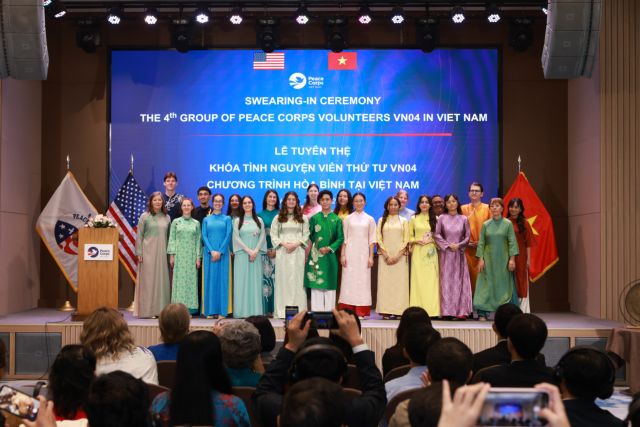 Sunday/Weekend
Sunday/Weekend

By Lê Hương
The West Lake in Hà Nội is famous for its beautiful lotus flowers. Particularly the rare variety of 'hundred-petal' lotus which gives off a distinctive aroma.
But culturally these flowers have another role to play: they are used to make a lotus-infused tea that is synonymous with the capital city.
"There is something in the nature of tea that leads us into a world of quiet contemplation of life," a philosopher once said. And it might just be that Hà Nội's lotus tea is greater for this purpose than any other.
Tea specialist Nguyễn Việt Bắc told Việt Nam News: “I think what makes lotus-scented tea so special is that it contains the essence of Hà Nội,”
“The lotus also has a religious significance. In the past, tea connoisseurs would take to the water in a lotus pond, and squeeze some dry tea inside lotus flowers late in the afternoon. Early the next morning, they would take back the tea that then already absorbed the aroma of the flowers. The method is so simple, yet the floral aroma in the tea is very fresh and clean.”
People often make lotus-scented tea during blooming season in summer between May and July.
This has been the main craft of Ngô Thị Thân’s family for decades.
“This is our traditional craft,” Thân said. “Of course, we make everything by hand with simple tools.”
Large half-bloomed lotuses are chosen as they are packed with stamen.
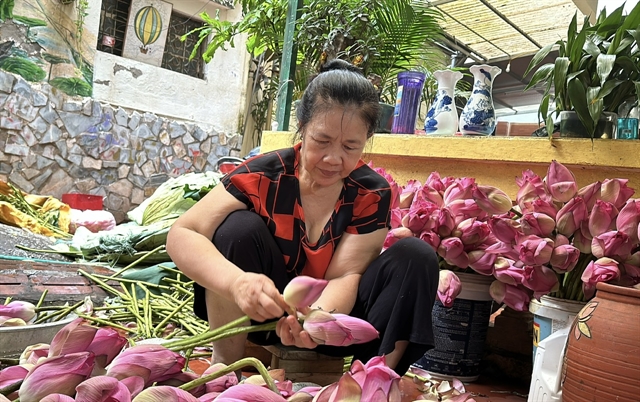 |
| BLOOMING LOVELY: Ngô Thị Thân prepares flowers for making lotus tea. VNS Photos Lê Hương |
The flowers are sorted carefully before the dry tea is crammed in. Almost no part of the lotus flower goes to waste in this process.
But the traditional way to infuse lotus aroma into tea is to mix lotus anthers with dry green tea.
About 1,000 lotus flowers yield one kilogram of anthers, the most aromatic part of the flower.
At first, the anthers are scattered on layer after layer of dry tea, then they are left in a container for one day. The next day the anthers are sorted out from the tea, which is heated again. The infusing process repeats five times so that the tea can fully absorb the scent of the lotus.
During the process, up to 1kg of anthers is used to make around 1kg of lotus tea.
According to Thân, they choose the most fragrant lotus and good quality tea. In recent years, they have freeze-dried the whole flower with the tea inside.
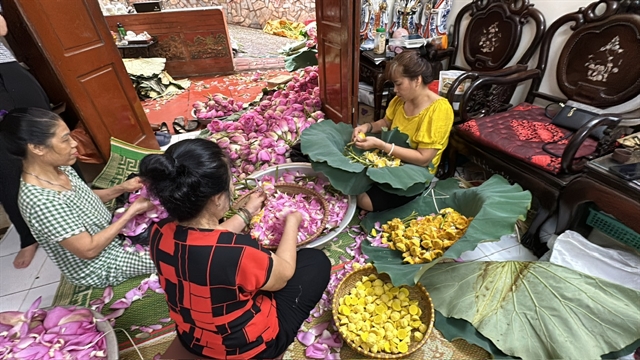 |
| SLOW AND STEADY: The process of infusing tea with lotus scent requires diligence and patience. |
“Lotus flowers have always been part of my life,” she said. “I think the scent is wonderful. The lotus brings me better stable income, and offers me chances to enjoy life. The craft requires people with peace inside their souls to make the tea. People who are active and like busy activities cannot manage it as the working process repeats so many times that it requires great patience.”
Thân also makes tea with grapefruit flowers and jasmine for the rest of the year.
“The lotus is wonderful but it cannot stand together with strong scent of fruit like that of jackfruit or durian,” she said. “We don’t use these fruits during the whole lotus season.
“From my grandmother’s time, even during wars, our family still makes lotus tea this way.”
Hundreds of people in Quảng Bá Village on the north-eastern bank of the West Lake still keep the traditional craft going strong.
Nguyễn Thị Thúy, a middle-aged lotus-scented tea maker, admitted the work was not difficult at all.
“But only diligent and patient people can do it well,” she said. “We have to take the anthers out from the lotus with great care, as they are the most valuable parts of the flower.”
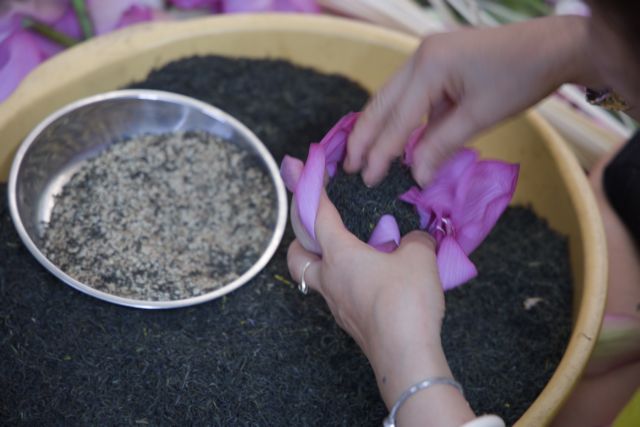 |
| PRETTY PETALS: Nguyễn Thị Thúy puts tea in a lotus flower. |
Thúy said she was very proud to be a part of a family with this traditional craft.
“I come here to support my aunt every lotus season,” she said. “I’ll do it until the time I cannot do it anymore.”
A lotus festival is slated in Quảng An Ward between July 12 and 16, when the local villagers are expected to receive official recognition for their West Lake lotus-scented tea as a national intangible heritage.
Tây Hồ District authorities are setting up a model of lotus planting together with ecological tourism. More than 7.5ha of lake in Quảng An and Nhật Tân wards will be used for planting high-quality lotus.
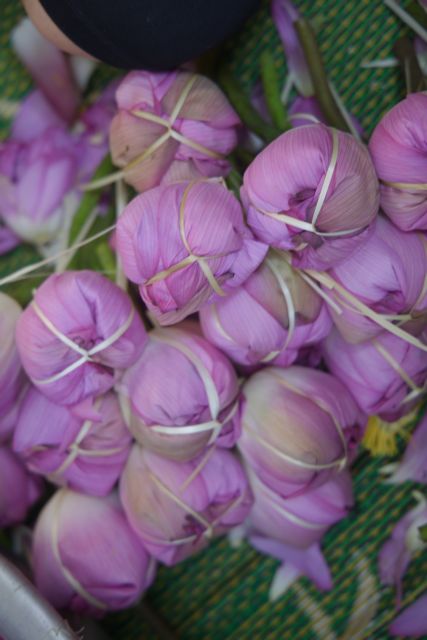 |
| INTENSE COLOUR: Tea wrapped inside lotus flowers and ready to be freeze-dried. VNS Photos Hải Anh |
“With the first lotus festival organised properly on a large scale, more visitors at home and from abroad will know about lotus flowers in the West Lake,” said Nguyễn Đình Khuyến, chairman of Tây Hồ District’s People’s Committee [district administration].
“Enhancing the role of Hà Nội’s lotus in today’s life is what the local artisans expect.”
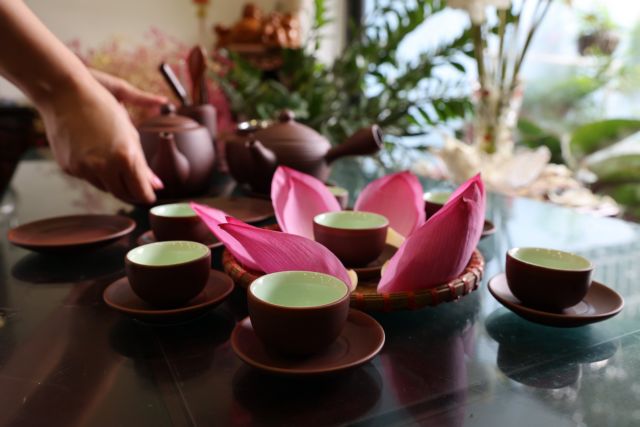 |
| HIGHLY PRIZED: Lotus-scented tea is a delicacy of Hà Nội. VNS Photo Nhật Hồng |
For Nguyễn Thanh Hằng, an overseas Vietnamese in Paris, lotus-scented tea is a cultural delicacy of not only Hà Nội, but also Việt Nam as a whole.
"When we open the package and make a pot of tea, I feel as if I am returning to familiar things through the aroma, the taste of the tea, the colour of the drink and gentle steam rising up," she said.
Hằng often invites her close friends for tea when they meet, especially for special occasions in Paris and when she wants to introduce Vietnamese delicacies to her French friends. She also sometimes drinks the tea while reading a book.
"When I make some lotus tea for myself, it helps create a special space and beautiful images and feelings about my homeland, connecting me with lotus lakes, nature and everything belonging to Vietnamese culture." VNS



